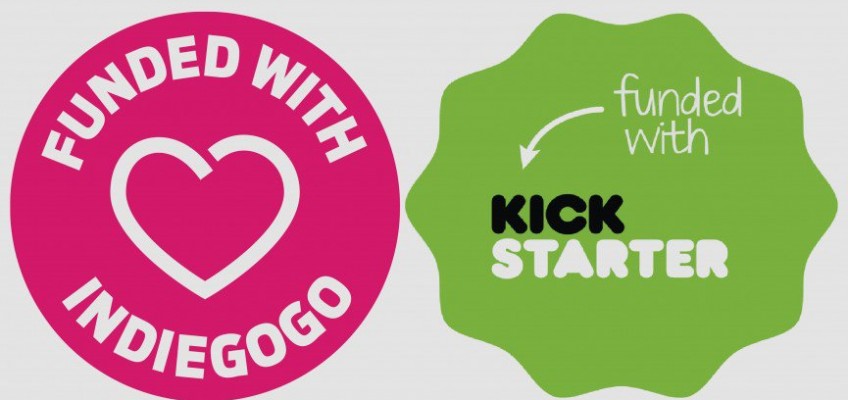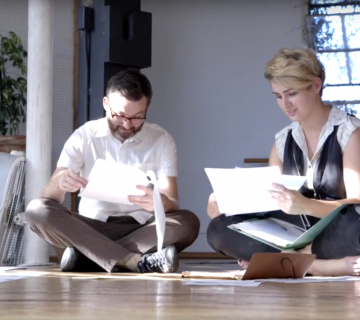Crowdfunding has changed the way independent filmmakers think about financing. It has created a new avenue of financial possibility. It’s safe to say that crowdfunding has empowered many an independent filmmaker to take a chance and believe in themselves, backed by a community of friends, family and film aficionados with a disposable income. After all, the mantra of the hopeful filmmakers turning to the crowdfunding community for a helping hand seems to be “if they can do it, so can I.”
But it’s not necessarily so.
Published author and screenwriter, Erik V. Wolter, recently turned to Indiegogo to help him and his crew over the finish line, producing the feature film adaptation of one of his novels, Break The Stage. Spoiler alert: They didn’t reach their goal.
Now, Erik seems to be a very professional, analytical and talented man. Someone who would do his research – and then some. He consulted the experts. He did everything by the book. So why did his campaign fail? Below are his own reflections on the failed crowdfunding campaign, but first a few stats and thoughts on the current state of crowdfunding:
In the US, the two main crowdfunding platforms are Indiegogo and Kickstarter. Indiegogo is by far the biggest in terms of launched campaigns, perhaps because of their flexible funding option (allowing project creators to collect the pledged money even if the campaign goal is not reached), but Indiegogo is also far ahead in terms of failed campaigns; 277,776 unsuccessful campaigns compared to ‘just’ 101,127 on Kickstarter. In fact, even though Kickstarter has hosted far less campaigns overall than Indiegogo, it has the highest number of successful campaigns at 70,812. Looking specifically at the Film & Video category things get really interesting: 41% of the campaigns on Kickstarter reached their goal, whereas only 11% on Indiegogo made it to the finish line. And those numbers are not just so far apart because of the volume on Indiegogo vs Kickstarter. More than twice the number of Film & Video campaigns were successfully funded on Kickstarter vs Indiegogo.
From what I have gathered during my research on the subject, the filmmaker (and crowdfunding project creator) has a few choices to make when choosing which platform to use. If you can ONLY complete your project with the help of the crowdfunding community, Kickstarter seems to be the way to go. It’s the all or nothing approach. After all, it’s not just about collecting money, it’s also about fulfilling your commitment to your backers and the perks you promised them. If you go with Kickstarter’s all or nothing model, you are at least guaranteed that you will have the funds to finish and honor your commitments. If you go with Indiegogo’s flexible funding option, you may end up with a project that does not have the budget to be successfully completed, but you still have to make good on your promises to your backers. My conclusion is that the flexible funding option on Indiegogo is only a safe and suitable option for project creators who could use the help of the community, but are able to complete the project with other means, if need be. One might say that with Indiegogo’s flexible funding option (which you don’t have to use, by the way) you take a financial gamble. With Kickstarter (or Indiegogo’s fixed funding option) you take a creative gamble. It’s all or nothing.
And this is not even mentioning platforms like Rockethub, Tubestart or Pozible. And even beyond those, there are many ways to fund your project. Most of them have pitfalls you need to wary of. All of them offer an opportunity to create. Here’s Erik V. Wolter’s experience with Indiegogo’s flexible funding model:
Thirty days ago when we launched our crowd funding on Indiegogo expectations were high. After all, 80% of the film was done, and our goal was only $35,000. The concept of raising money without giving up equity, and the successes of present and past campaigns of films on Indiegogo made it so very enticing. We had a trailer to show our work and an extensive network of connections to give us that initial boost everyone says you need in the first week. Even the people at Indiegogo agreed that we followed their guidelines and suggestions on the wording for our email contacts, Facebook, and Twitter posts. We had a progressive set of attractive Perks for contributions ranging from $10 to $5,000. The feedback for our video pitch and trailer was extremely positive.
Books and blogs are available on crowd funding about what to do and not do. There is also an abundance of material out there that analyzes those funding campaigns that fail to meet their goal. Allow me to put in my two cents and at the same time be as transparent as possible about the outcome. My brief analysis may be too simplistic and may or may not be meaningful for everyone, but I’m fairly confident that it was the primary factor in our inability to reach our goal, and is worth considering should anyone be thinking of taking the crowd funding plunge, be it Indiegogo or any other of the popular platforms out there.
“The best-laid schemes of mice and men…” – you probably know the rest.
At the end of our campaign, after 3300 visits to our campaign site and 220 referrals, we had 41 contributors and raised a grand total of $4200, meaning we achieved a mere 12% of our goal.
An interesting adventure, to be sure. A lesson learned, most definitely. A critique of human behavior, without a doubt.
Apparently, as the numbers seem to infer, sharing Facebook posts, tweets and re-tweets, emails, and follow up emails will bring the horse to water but not much else. Maybe people assumed if you let others know, others would contribute. But then those others let people know and then they assumed… Of course, some didn’t let others know at all, but assumed somebody else would.
Human nature is more often than not inexplicable, but perhaps there was something about our appeal that didn’t make it clear that asking for help to reach our goal didn’t mean just pass that message on. The link “click here to make a contribution” was intended for them, too. Of course, not contributing is a choice and that should be respected, but when friends, family, colleagues, and associates think enough of your efforts to promote your campaign, wish you the best, and say they can’t wait to see the movie, but won’t drop ten or twenty bucks in as a contribution, it is a definite head-shaker.
Some simple math: If 1200 of the 3172 who visited our site but didn’t contribute would have contributed $25, we would be at 98% of our goal. If 750 would have contributed $50, we would have exceeded our goal by $2500 (107% of goal). Interesting, indeed. However, as my father reminded me more than once, “If if’s and buts were candy and nuts, every day would be Christmas.”
Despite this setback, the team of Producers behind this project is committed for the long haul. To paraphrase, the late great film critic, Roger Ebert, we will see you at Break the Stage the Movie.







Join the Conversation →